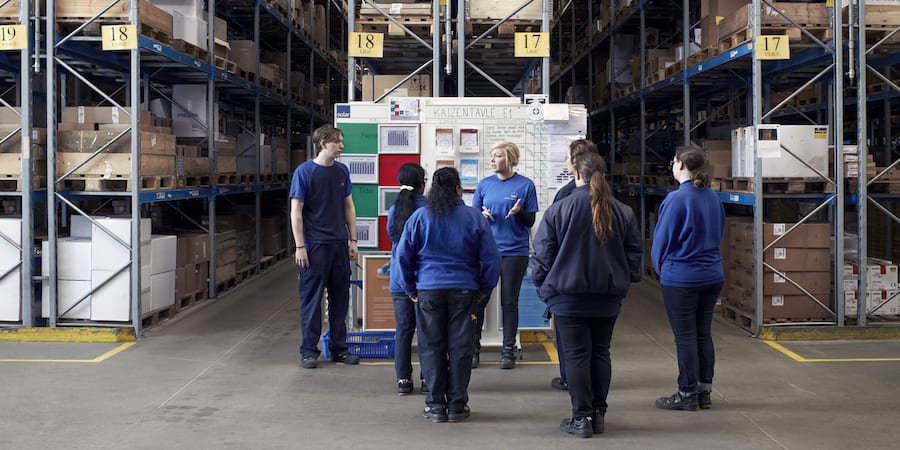
As lean expands, new tools help to build stronger networks
COLUMN - As the lean community grows, experimenting with tools for self-organization like Open Space in order to build stronger lean networks.
Words: Lex Schroeder, former Editor, Lean Post
Joi Ito, Director of MIT’s Media Lab, uses these nine principles below for heading up the Lab and understanding networks. Half of them sound pretty lean to me. Others, not so much.

As editor of The Lean Post, I spend a lot of time thinking and talking with folks about how to share lean knowledge and learning most effectively. High impact lean knowledge like Tracey Richardson’s advice for creating a great A3 that she picked up at Toyota, interesting transformation stories like “Structured Experiments into the Unknown” by Linus Brodén, and valuable conversation starters like Eric Ethington’s piece “Gather the Facts: How Does Your Organization View Lean?” are pieces that we hope reach as many people as possible.
The goal is not just to share lean knowledge with LEI community members, but also across the larger lean community and various communities of practice. And here’s where networks come in. Part of any editor’s (or change agent’s?) “capability development” is understanding not just what kind of stories get people’s attention and make learning possible, but also how information travels online and offline. The truth is, effective learning and sharing doesn’t just happen – like anything else, they need to be designed.
One way to design for effective learning and sharing in person is to run something called an Open Space, or as some folks know it, an “unconference.” Open Space is all about creating a structure for self-organization. You can learn more about Open Space here, but in short, it’s a tool to help people have the conversations that they want and need to have about their work. It helps build networks and also makes already existing networks more visible.
What is more helpful than encouraging dialogue in a community of people striving to fully embrace lean principles? Yet, running these sessions has taught me that promoting self-organization in the lean community can be a challenge: in many ways self-organization and lean thinking are totally aligned, but in many other ways they aren’t.
Lean welcomes ideas for improvement to come from anywhere. Self-organization depends on the same. Lean requires and rewards problem solving and personal initiative. So does self-organization. But lean is also all about giving organizations and individuals a clear, reliable, vertical and horizontal framework for solving problems. While self-organization requires structure (albeit a light one), it isn’t based on hierarchy and it isn’t prescribed. It’s not predictable and it isn’t contained to organizations.
For example, in an Open Space session, leadership looks like participants volunteering to host a conversation or someone volunteering to take good notes and letting what comes up in the conversation inform that group’s next actions. It could or could not emerge from the ground up. Facilitators can’t force it and neither can hosts. Open Space is time boxed and has a certain amount of “standard work,” but it’s up to participants to make it a success. It deals with abstract ideas, not targets, and breakout conversations rely on principles like “When it’s starts, it starts,” and “When it’s over, it’s over,” and “Whatever happens is the only thing that could have.” Which is why some small group conversations gain traction and create vital connections (and actions!) long after they’re over and others don’t. It’s also why some people find Open Space surprisingly useful and energizing and others feel like they are being set up to fail. Lean and self-organization of communities both depend on people, but in different ways.
Looking at Ito’s principles again and thinking about the lean organization, safety and compliance are absolutely relevant. Even when leaders act like coaches, authority is important. Value stream maps are crucial for understanding the work to be done.
But it’s all different in a lean network. In a network, it’s about emergence. In the lean healthcare community of practice in the U.S., this might look like one executive at a health center in Indiana picking up the phone and calling another executive at a hospital in Colorado and saying, “Can I learn more about what you’ve all been doing?” and two years later, something fantastic coming out of that interaction. In the LPPD community of practice, it’s about a member of the design thinking community who is more familiar with lean startup principles chatting with someone from the agile community who is very familiar with Lean Thinking and saying “Let’s collaborate.” Many of us do things like this already, but we don’t always track these interactions as “work” or understand this kind of activity as part of our jobs.
As the lean community grows and changes, whose role is it to guide how lean knowledge spreads? What does it take to spread lean knowledge far and well? Does effective learning and sharing change according to industry? These are worthwhile questions for editors and “practitioner-writers” as I’ve come to call them, but they may just be important questions for everybody.
THE AUTHOR

Read more


FEATURE ARTICLE – Danish company Solar has applied lean management principles to the rollout of a new ERP system to gradually strengthen the ties between an isolated IT department and the rest of the organization.


FEATURE – In this call to arms, the author encourages us to fight to prove the relevance of Lean Thinking in such difficult times and explains why only mastering it can truly address our problems.


FEATURE – Improving supplier quality and reduce defects was an important part of Toyota Industries Corporation’s (TICO) Dantotsu activities since the very beginning. In this article, the author visits two parts suppliers.


FEATURE – Much has been said and written about Toyota’s ability to recover from disasters. What many don’t realize, however, is that the company’s recovery strategy is informed by its underlying values – not just its tools.

